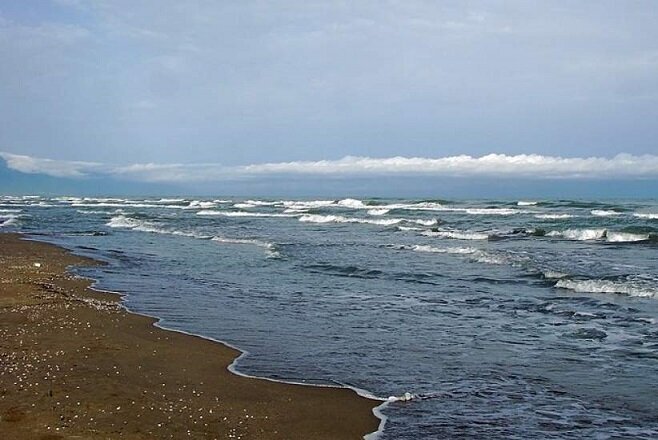Caspian Sea water level predicted to decrease by 2100

TEHRAN – The water level of the Caspian Sea is expected to significantly decline by the year 2100.
Scientific research and ongoing monitoring reveal that the Caspian Sea is bound to experience a decline in its water balance and shrinkage by 2100, as a result of the ever-changing climate conditions, the director of the National Center for Caspian Sea Studies and Research has said.
If this prediction turns out to be accurate, it will bring about a substantial and transformative effect on the Iranian coast, particularly in the southeastern region of the Caspian Sea, Seyyedeh Masomeh Bani-Hashemi explained on Saturday, ISNA reported.
The most recent studies reveal that during the previous Iranian year of 1401 (which ended on March 20), the water level of the Caspian Sea witnessed a significant decrease of 26 centimeters, surpassing the already concerning decrease of 24 centimeters observed in 1400, she noted.
In the past two years, the water level of the Caspian Sea has experienced a significant decrease of approximately 50 centimeters, she stated.
Since 1995, the water level of the Caspian Sea has steadily declined, resulting in an approximate decrease of two meters over the years, she mentioned.
The Caspian Sea is known for its fluctuating nature, characterized by recurring cycles of rising and falling sea levels.
Ever since the first water level measuring station was established in Baku in 1837, and the Caspian Sea's water fluctuation was registered by the device's oscillator, the sea's behavior has shown various levels of ups and downs.
Located in Bandar Anzali, the oldest water level measuring station in Iran was established in 1941 and its findings also indicate diverse fluctuating behavior of the Caspian Sea.
Between 1977 and 1995, there was a remarkable rise in the water level of the Caspian Sea, amounting to an impressive increase of approximately 2.5 meters. Extensive studies were conducted during this period to evaluate various factors, marking the beginning of a downward trend in the sea level.
“Rainfall and inflow of river water are the key drivers of the Caspian Sea's water level, however, it is the water flowing in from the rivers that has the most significant impact on raising the water level,” Bani-Hashemi said and added: “The second most vital factor is surface precipitation.”
One of the most crucial factors in the loss of water from the surface of the Caspian Sea is the annual evaporation of one meter, which can vary depending on the different coasts, she said.
In the southern regions of the Caspian Sea, the yearly evaporation rate is significantly higher, she added.
The availability of river water resources can vary and is estimated to range from 300 to 320 billion cubic meters per year and this estimate takes into account factors such as climatic conditions and water consumption patterns, she noted.
The Caspian Sea is the largest enclosed inland body of water on Earth by area. It is bounded by Kazakhstan to the northeast, Russia to the northwest, Azerbaijan to the west, Iran to the south, and Turkmenistan to the southeast. The sea has an area of 600,384 square kilometers and a coastline of 7,000 kilometers.
Hosting 400 aquatic species and holding third place in terms of oil and gas reserves under its bed after the “Persian Gulf” and “Siberia” has doubled the value of this basin, while sturgeon are the most important inhabitants of the lake.
Researchers believe that 80 percent of the pollution in the Caspian Sea is related to the flow of water from the Volga River and other western rivers from the Republic of Azerbaijan.
Frequent oil spills in the coastal areas of Azerbaijan and Kazakhstan, the entry of waste from over 40 factories and refineries into the sea, and the decline, and extinction of the Caspian Sea aquatic species since 1990, are among the main challenges faced by the Caspian Sea.
The National Institute for Oceanography and Atmospheric Science has conducted extensive studies in this catchment area, including more than 10 research patrols in the Caspian Sea, obtaining a certificate and setting up a trusted laboratory of the Department of Environment, identification of high-risk points for cracking waves on the shores of the Sea.
Moreover, sampling of bed sediments in the deep waters of the southern Caspian Basin, publication of more than 80 scientific documents on the Caspian Sea, study, measurement, and modeling in Gorgan Bay, and presented scientific and executive solutions for the sustainability of its ecosystem and more than 70 research projects in the southern part of the Caspian Sea are other actions of researchers at the Research Institute.
Grappling with poor waste management
Ahmad Reza Lahijanzadeh, deputy chief of the Department of Environment (DOE) for the marine environment, said in August 2020 that waste management in the Caspian Sea is on the verge of crisis and seriously threatens the Sea’s environment.
In addition to waste, leachate enters the sea through rivers or rainfall, and because the severity of leachate pollution is very high, it imposes a serious threat to the marine environment, he lamented.
Noting that the release of urban and rural wastewater into the sea is another problem the Caspian Sea is struggling with, he clarified that a number of cities in the northern provinces either do not have a wastewater treatment plant.
Stating that plastics and microplastics are among the issues that can be a threat to humanity in the next 10 years, he noted that erosion makes microplastics out of plastic waste, and 70 percent of these are transferred directly to the seas and therefore can enter the aquatic and human food cycle, causing damage to human health and marine biodiversity.
ABU/
Leave a Comment